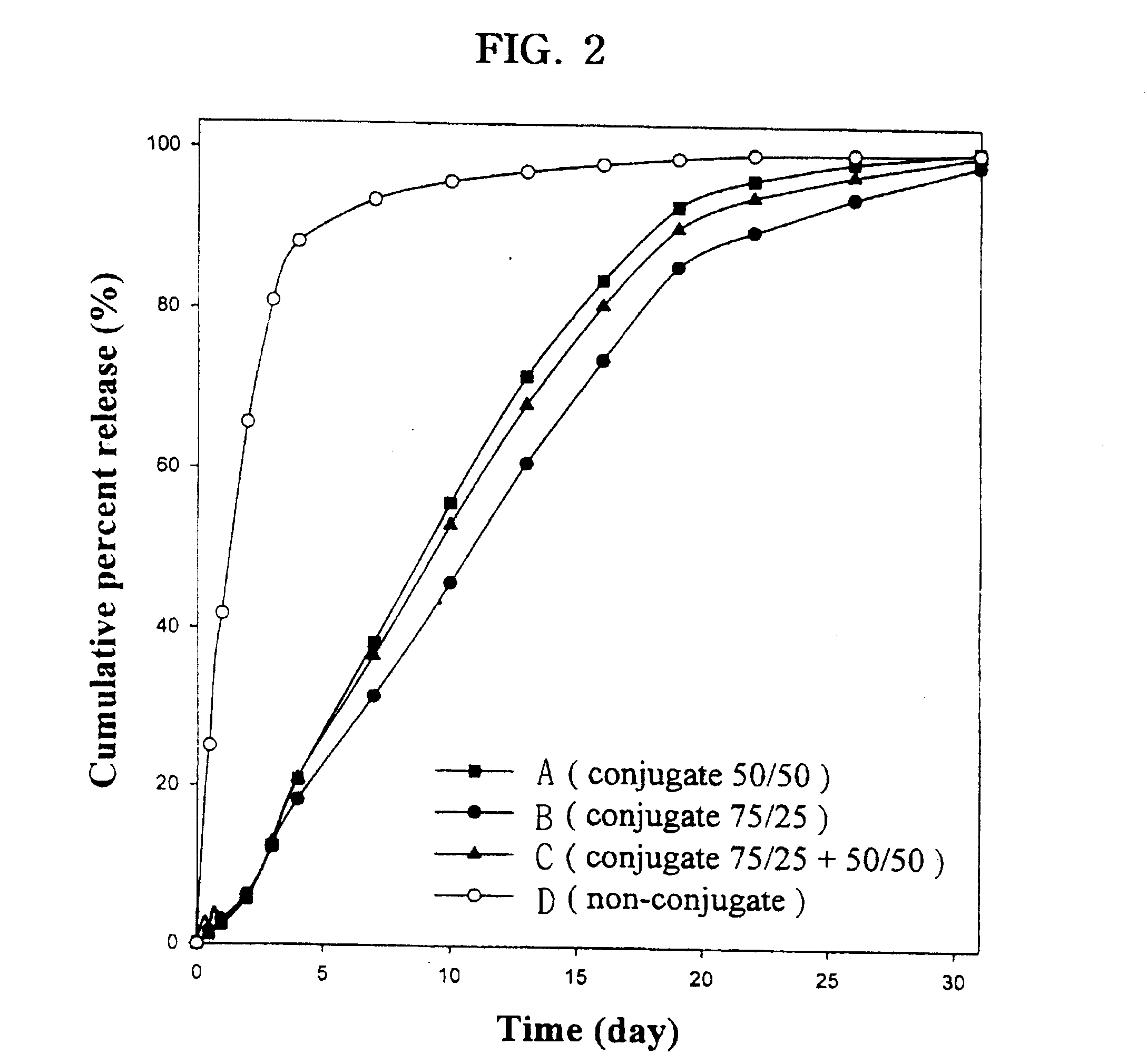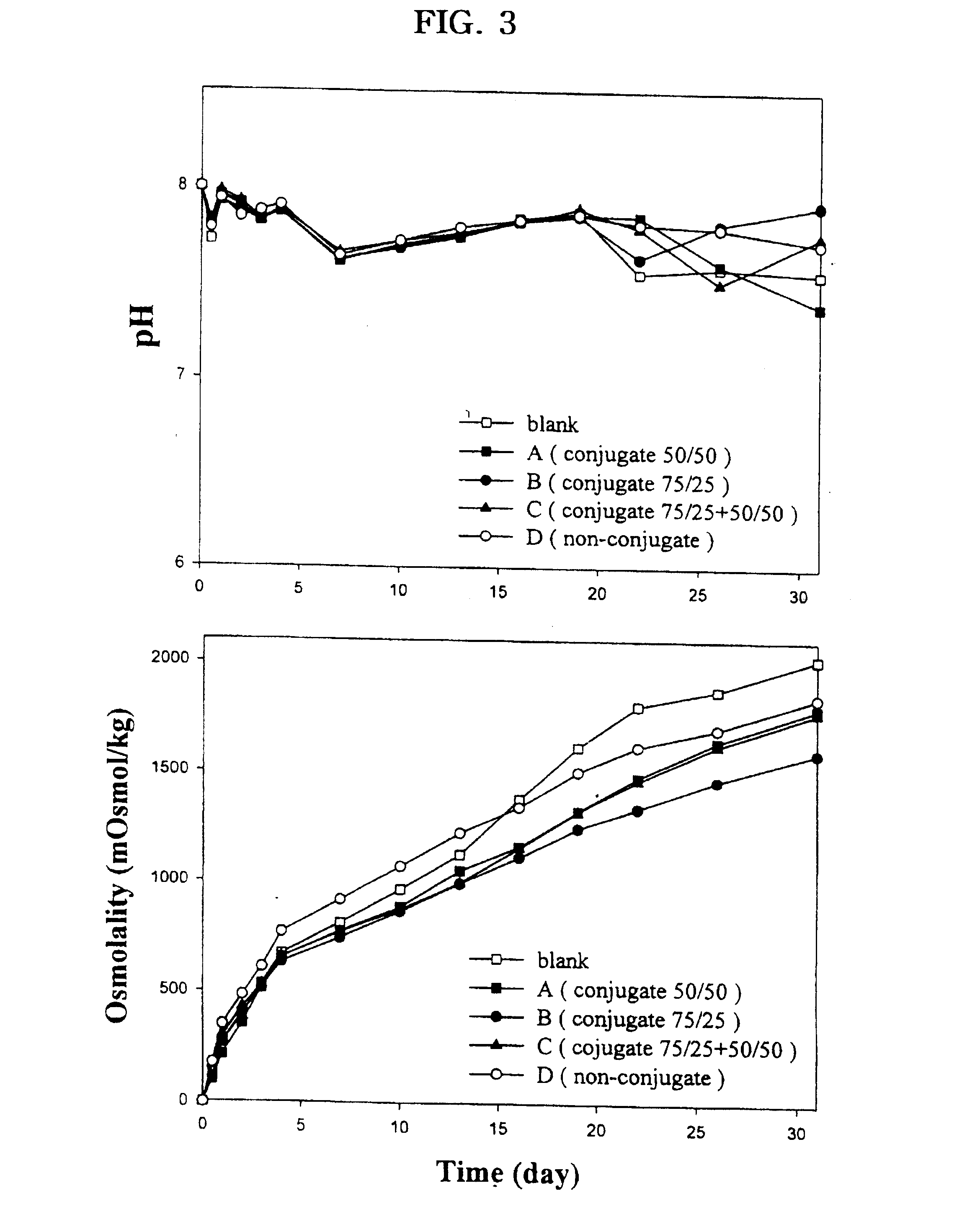Controlled drug delivery system using the conjugation of drug to biodegradable polyester
a drug delivery and biodegradable technology, applied in biocide, peptide/protein ingredients, microcapsules, etc., can solve the problems of difficult control of the release rate of drugs, difficulty in maintaining constant drug concentration in blood, and serious problems
- Summary
- Abstract
- Description
- Claims
- Application Information
AI Technical Summary
Benefits of technology
Problems solved by technology
Method used
Image
Examples
example 1
Coupling Molecule to PLGA via Covalent Bond
[0069] (1) Coupling Peptide to PLGA via Amide Bond
[0070] Antifungal peptide (PCT-KR 96-0034, KYIVFVFK) filed by this applicant was synthesized by using automatic 431A peptide synthesizer (Biosystems) through solid phase synthesis, and then deprotected by trifluoroacetic acid solution. Purified product was obtained using reverse phase high performance liquid chromatography (HPLC).
[0071] After dissolving PLGA5010 (Mw 10,000, lactic acid:glycolic acid, 1:1 mole ratio) in mixed solvent including N,N-dimethylformamide and methylene chloride, the above peptide dissolved in a small dose of dimethylformamide was added. Coupling reagent of EDC / HOBt or DCC / HOBt and base of triethylamine were added, and this solution was stirred at room temperature for 12 hours. Reaction process was assayed, using thin layer chromatography and gel permeation chromatography (GPC).
[0072] After the reaction was completed, ether was added and the precipitate was dissolved...
example 2
Coupling Molecule to Activated PLGA via Covalent Bond
[0077] (1) Method for Activating PLGA: Synthesis of p-nitrophenyl Carbonate of PLGA
[0078] p-nitrophenyl chloroformate was dissolved in dried methylene chloride, and then temperature was lowered to 0.degree. C. PLGA5010 dissolved in dried methylene chloride was added to the above solution. Pyridine was added and stirred at 0.degree. C. for 30 minutes, then further stirred at room temperature for 1.about.3 hours or stirred at 0.degree. C. for 3.about.6 hours. Precipitate was formed with ether.
[0079] By precipitation using ether and methylene chloride, product was purified and characterized by gel permeation chromatography and UV spectrum.
[0080] (2) Coupling Antifungal Peptide with Activated PLGA
[0081] Antifungal peptide dissolved in dimethylformamide was slowly added to polymer solution of the above step 1. Triethylamine was added to the solution and stirred at room temperature for 6.about.24 hours. Reaction process was monitored, u...
example 3
Coupling Activated Molecule to PLGA via Covalent Bond
[0092] Coupling Fmoc-Trp(Boc) to PLGA via Ester Bond
[0093] (1) Coupling Reaction of Fmoc(Boc) to PLGA
[0094] Various coupling reagents and reaction conditions were studied in the conjugation of various molecules into polyester polymer. First, different coupling reactions were explored by employing various coupling agents for poly(D,L-lactic-co-glycolic acid) (PLGA) 50 / 50 to maximize the conjugation yield. Poly(D,L-lactic-co-glycolic acid) (lactic acid / glycilic acid ratio, 75 / 25 and 50 / 50) were purchased from Wako Pure Chemical Industries Ltd. (PLGA 5010 and 7510). The two PLGA polymers with 75 / 25 and 50 / 50 lactic / glycolic monomer composition ratios had molecular weight (Mw) of 9,800 and 8,700, respectively, as determined by gel permeation chromatography. The PLGA polymer used in this reaction had an uncapped free carboxylic acid group at one terminal end and a hydroxyl group at the other end. Typically, Fmoc-Trp(Boc) (80 mg, 1.5.ti...
PUM
| Property | Measurement | Unit |
|---|---|---|
| size | aaaaa | aaaaa |
| size | aaaaa | aaaaa |
| molecular weight | aaaaa | aaaaa |
Abstract
Description
Claims
Application Information
 Login to View More
Login to View More - R&D
- Intellectual Property
- Life Sciences
- Materials
- Tech Scout
- Unparalleled Data Quality
- Higher Quality Content
- 60% Fewer Hallucinations
Browse by: Latest US Patents, China's latest patents, Technical Efficacy Thesaurus, Application Domain, Technology Topic, Popular Technical Reports.
© 2025 PatSnap. All rights reserved.Legal|Privacy policy|Modern Slavery Act Transparency Statement|Sitemap|About US| Contact US: help@patsnap.com



